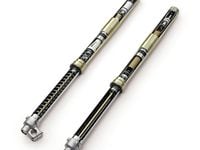****It's easy to see the difference between KYB's conventional MX fork (left) and its new PSF design (right): one has a spring, the other doesn't.****
WORDS: Aaron Frank
** PHOTOS: Honda**
Air suspension isn’t anything new. As recently as the 1980s, sportbikes used compressed air either as the springing medium or to assist a conventional coil spring. Heck, certain Victory and Kawasaki cruisers use air shocks today. Performance issues including increased stiction, big-hit blowouts and a changing “spring” rate as the suspension heats up have so far limited the usefulness of air shocks for racing or other high-performance applications.
Until now: Advances in materials and manufacturing processes have reportedly eliminated these potential problems, leading Japanese suspension giant Kayaba (KYB) to develop the all-new Pneumatic Spring Fork (PSF) that debuted on the 2013 Honda CRF450R and Kawasaki KX450F motocross machines. Kayaba says the advantages are significant. Replacing coiled-metal springs with a column of air reduces unsprung weight nearly two pounds, and makes fine-tuning spring preload as easy as adjusting the air pressure in your tires, via a Schrader valve mounted at the top of the fork leg.
Deleting the springs makes room for a bigger piston, expanding from 24mm to 32mm to provide more precise damping response. Initial impressions have been positive, with riders across the age and experience range—including ex-editor Catterson—praising the PSF for exceptional stability and small-bump compliance. If air shocks fly on the high-flying MX circuit, look for this weight-saving technology to “revolutionize” sportbike suspension next.











/cloudfront-us-east-1.images.arcpublishing.com/octane/VZZXJQ6U3FESFPZCBVXKFSUG4A.jpg)
/cloudfront-us-east-1.images.arcpublishing.com/octane/QCZEPHQAMRHZPLHTDJBIJVWL3M.jpg)
/cloudfront-us-east-1.images.arcpublishing.com/octane/HXOUJXQWA5HBHGRO3EMJIGFMVI.jpg)

/cloudfront-us-east-1.images.arcpublishing.com/octane/3TIWWRV4JBBOLDVGRYECVVTA7Y.jpg)
/cloudfront-us-east-1.images.arcpublishing.com/octane/KIX5O23D5NAIBGFXBN3327DKZU.jpg)
/cloudfront-us-east-1.images.arcpublishing.com/octane/7GJYDUIPXRGMTMQKN6ONYOLBOU.jpg)
/cloudfront-us-east-1.images.arcpublishing.com/octane/MUQLOVLL2ZDGFH25ILABNBXKTI.jpg)
/cloudfront-us-east-1.images.arcpublishing.com/octane/TNOU5DNE2BC57MFPMGN2EIDXAM.jpg)
/cloudfront-us-east-1.images.arcpublishing.com/octane/GTCXACQGJ5HAPDTGWUQKDEH44E.jpg)
/cloudfront-us-east-1.images.arcpublishing.com/octane/S35YGSEMEZB4BLTDJTSZPF4GLA.jpg)
/cloudfront-us-east-1.images.arcpublishing.com/octane/5UOT6HPX2JFMRJAX6EH45AR4MQ.jpg)
/cloudfront-us-east-1.images.arcpublishing.com/octane/OKWOJWAKP5EP3OACCRRWPCIX2Q.jpg)
/cloudfront-us-east-1.images.arcpublishing.com/octane/2WF3SCE3NFBQXLDNJM7KMXA45E.jpg)
/cloudfront-us-east-1.images.arcpublishing.com/octane/G4MG6OUCJNBSHIS2MVVOTPX65E.jpg)
/cloudfront-us-east-1.images.arcpublishing.com/octane/IIGGWFOTOJGB7DB6DGBXCCMTDY.jpg)
/cloudfront-us-east-1.images.arcpublishing.com/octane/QSTCM6AVEZA5JJBUXNIQ3DSOF4.jpg)
/cloudfront-us-east-1.images.arcpublishing.com/octane/U4I7G625B5DMLF2DVIJDFZVV6M.jpg)
/cloudfront-us-east-1.images.arcpublishing.com/octane/B6XD6LS6IVCQPIU6HXDJSM3FHY.jpg)
/cloudfront-us-east-1.images.arcpublishing.com/octane/ICL63FEDDRDTTMINYICCEYGMDA.jpg)
/cloudfront-us-east-1.images.arcpublishing.com/octane/FCGZHQXRBZFLBAPC5SDIQLVF4I.jpg)
/cloudfront-us-east-1.images.arcpublishing.com/octane/WNOB6LDOIFFHJKPSVIWDYUGOPM.jpg)

/cloudfront-us-east-1.images.arcpublishing.com/octane/X33NU3E525ECRHXLNUJN2FTRKI.jpg)